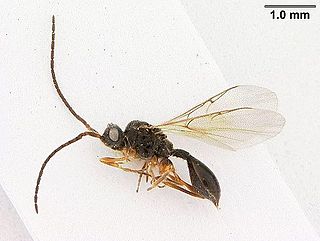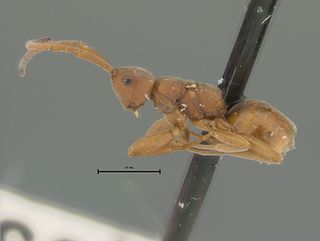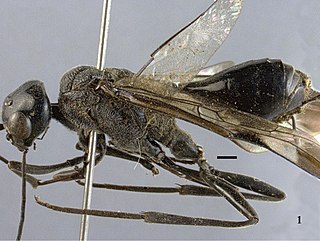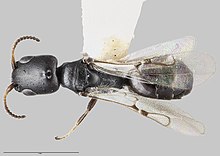Michael S. Engel, FLS, FRES is an American paleontologist and entomologist, notable for contributions to insect evolutionary biology and classification. In connection with his studies he has undertaken field expeditions in Central Asia, Asia Minor, the Levant, Arabia, eastern Africa, the high Arctic, and South and North America, and has published more than 925 papers in scientific journals and over 1000 new living and fossil species. Some of Engel's research images were included in exhibitions on the aesthetic value of scientific imagery.

The Mymarommatoidea are a very small superfamily of microscopic fairyfly-like parasitic wasps. It contains only a single living family, Mymarommatidae, and three other extinct families known from Cretaceous aged amber. Less than half of all described species are living taxa, but they are known from all parts of the world. Undoubtedly, many more await discovery, as they are easily overlooked and difficult to study due to their extremely small size.

The Stephanidae, sometimes called crown wasps, are a family of parasitoid wasps. They are the only living members of the superfamily Stephanoidea. Stephanidae has at least 345 living species in 11 genera. The family is considered cosmopolitan in distribution, with the highest species concentrations in subtropical and moderate climate zones. Stephanidae also contain four extinct genera described from both compression fossils and inclusions in amber.

The Diapriidae are a family of parasitoid wasps. These tiny insects have an average length of 2–4 mm and never exceed 8 mm. They typically attack larvae and pupae of a wide range of insects, especially flies. The about 2,300 described species in around 200 described genera are divided into three subfamilies, and the group has a global distribution.

The Sierolomorphidae are a family of 13 extant species of wasps, in the genera Sierolomorpha and Proscleroderma, mostly found in the Northern Hemisphere. They are rare and very little is known of their biology. A fossil species Loreisomorpha nascimbenei has also been placed in the family.
The Scolebythidae are a small family of aculeate wasps in the superfamily Chrysidoidea. These chrysidoid wasps are found in Africa, Australia, the Neotropics, north China, Thailand and Fiji. They are parasites on larvae of Cerambycidae and Ptinidae.

Spathiopterygidae is an extinct family of small parasitic wasps, known from the Cretaceous of Laurasia and Northern Gondwana. They are suggested to be members of Diaprioidea, in part due to their similarly reduced wing venation. Some members of the group reduced or lost the hindwings entirely.
This list of fossil arthropods described in 2013 is a list of new taxa of trilobites, fossil insects, crustaceans, arachnids and other fossil arthropods of every kind that have been described during the year 2013. The list only includes taxa at the level of genus or species.

Maimetshidae is an extinct family of wasps, known from the Cretaceous period. While originally considered relatives of Megalyridae, they are now considered to probably be close relatives of Trigonalidae.
Serphitidae is a family of microscopic parasitic wasps known from the Cretaceous period.

Embolemidae is a family of small solitary parasitoid wasps with around 70 species in 2 genera distributed around the world. The few species whose biology is known are parasites on planthopper nymphs of the families Achilidae and Cixiidae. There is debate regarding the status of the genus named Ampulicomorpha by Ashmead in 1893, generally considered now to be a junior synonym of Embolemus (e.g.,), though some authorities dispute this (e.g.,)

Epyris is a genus of cuckoo wasps in the family Bethylidae. There are at least 50 described species in Epyris.

Goniozus is a genus of parasitic wasps in the family Bethylidae. There are at least 20 described species in Goniozus.

Sclerodermus is a genus of cuckoo wasps in the family Bethylidae. There are at least 20 described species in Sclerodermus.

Hyptia is a genus of ensign wasps in the family Evaniidae. There are at least 50 described species in Hyptia. Most Hyptia can be differentiated from other genera by heavily reduced venation of the forewings, wherein only one closed cell is present.

Aulacus is a genus of aulacids, ensigns, and gasteruptiids in the family Aulacidae. There are 77 species of Aulacus.
The Gallorommatidae is an extinct family of microscopic parasitoid wasps, belonging to the Mymarommatoidea. It is known from several species found in Cretaceous aged amber.
Laelius is a genus of hymenopteran parasitoids in the family Bethylidae. Laelius species are ectoparasitoids of immature stages of beetles, such as Dermestidae, and thus are commonly taken indoors. There are 57 extent species worldwide and 4 additional species known from fossil records in amber. A number of species have recently been moved from the genus Rhabdepyris to Laelius.
Jouault, Corentin; Rosse-Guillevic, Simon. "A new genus of praeaulacid wasp from the mid-Cretaceous Kachin amber (Myanmar)". Annales de Paléontologie. 109 (1): 102599. doi:10.1016/j.annpal.2023.102599.

Embolemus is a genus of wasps belonging to the family Embolemidae. There is debate regarding the status of the genus named Ampulicomorpha by Ashmead in 1893, generally considered now to be a junior synonym of Embolemus (e.g.,), as a few authorities dispute this (e.g.,).



















